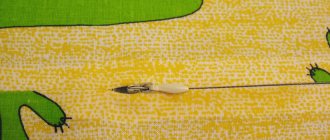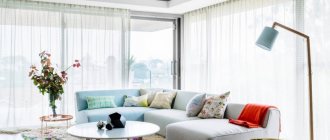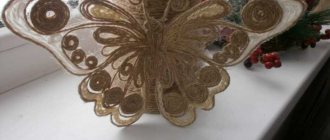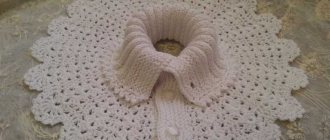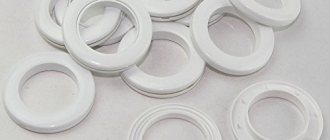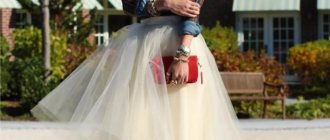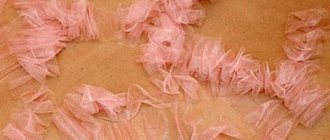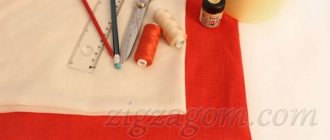Lambrequin: past and present
Lambrequins were historically designed to hide the cornice. These were wooden carved structures, richly decorated, which created a luxurious window frame in combination with expensive draperies.
And if classic soft lambrequins with multi-layer draperies are becoming a thing of the past, remaining only in the design of theaters, museums and other public institutions, then new types of lambrequins, on the contrary, are becoming fashionable.
Lambrequins are not suitable for all rooms. Regardless of the interior style and curtain fabric, a complex lambrequin attracts attention, thereby drawing the eye to the ceiling. For rooms with low ceilings (less than 2.7 m) this design is not suitable, because... visually weighs down the window, making it squat, which makes the ceiling seem even lower.
A classic of the genre - a real hard lambrequin
Those for whom a model based on adhesive bandeau fabric is not enough can make lambrequins with their own hands on a plywood frame.
For this purpose, you need plywood 1.5-2 cm thick and wood screws. Cut out the details of the box (sides, top bar, front wall and back). Connect the frame parts with self-tapping screws.
Prepare the fabric by cutting out a rectangle 15 cm longer than the total length of 2 sidewalls and the frame facade, and 5 cm wider than the facade. Make a gasket and padding polyester of the same size. For the lining, you need to make a rectangle 5 cm shorter than the front fabric.
Glue the padding polyester onto the box along the facade and sides. Sew the lining and front fabric. Using a furniture stapler, first attach it along the bottom border of the box.
Pull the front part of the fabric onto the facade. Bring the edges to the top of the box and shoot with a stapler. Cover the sides.
Turn the box over, place the lining on the inside, and secure with staples.
To decorate the top, cut the fabric of the required size with a hem allowance of 1.5-2 cm. Secure it with staples in the center and in the corners, then tuck the sections inward and secure them. Install hangers on the backdrop, mark their location on the wall, install fasteners and hang them.
Such a lambrequin can be decorated with cord and fringe, hanging elements, applique, etc.
p. You can attach additional draperies by laying the assembly and shooting it with staples. There can be a lot of design options, you just need to use your imagination.
A rigid bandeau lambrequin, even the most elaborate one, can be easily made with your own hands. The main thing when creating it is the clarity and accuracy of edge processing. You can decorate a rigid base in different ways.
Save
After hanging curtains on the cornice, the understanding often arises that in order to achieve a more attractive appearance, in addition to drapes and curtains, the window opening must also be decorated with a lambrequin.
If the curtains were made independently, then you can make a suitable option in the same way. In this case, it is best if this detail of the window design is rigid, providing not only a more attractive appearance of the curtains, but also visually hiding the cornice. And if you need a hard lambrequin, then you can do this work quite simply and quickly, and do it yourself.
DIY simple lambrequins
A simple lambrequin is a strip of fabric that is attached to or above the curtain rod, hiding it and the top of the curtain. Simple drapery can be made in the form of a gather or fold. The lower cut of the lambrequin can be simple - horizontal or figured - in the form of an arch.
For interiors in country or Provence style, which involve curtains made of natural linen or cotton, window decoration using a simple lambrequin remains relevant.
How to perform sewing steps
You should follow the instructions:
Related article: Design of a one-room apartment with a niche
Pattern of a rigid lambrequin.
- Apply a special pattern prepared in advance to cut out the base of the bandeau.
- Iron the fabric with a warm iron.
- The fabric is glued onto the bandeau with a warm iron.
- Excess fabric from the edges is trimmed to 5 cm.
- Next, the fabric is placed on the lining.
- Using pins, pierce three sides without the top.
- Sew one centimeter from each edge of the bandeau.
- Next, the excess fabric is trimmed.
- After this, the product is straightened to the front side.
- The upper edge is turned right side out, pulled taut, and pinned with a pin.
- After this, you need to pin the Velcro on the hard side to the cornice.
- After this, the Velcro is fixed with machine stitching.
- Next, you need to trim the material exactly next to the adhesive tape.
- After this, the adhesive tape is unscrewed and pierced with a pin.
If this method of making a rigid lambrequin is too complicated, then the panel is made without a special lining, cutting off the fabric exactly where the edge of the adhesive base passes. Using a glue gun, reinforce the finishing material along all edges. The decoration can be cord, braid, fringe.
In the process of making a rigid lambrequin yourself, you should follow a few simple steps:
To sew a lambrequin you will need a roll of thick fabric.
- Make a regular pattern. First, for the template, exactly all the dimensions of the future gang lambrequin are taken. It is first necessary to determine exactly how the product will look, covering the entire cornice. The shape of the bandeau can be strict or have shapes and teeth.
- You will need to buy a frame, that is, a finished bandeau-pro product in a roll. This is a dense fabric, which is non-woven or dublerin, perhaps also a material for decoration.
- According to the pattern, it is necessary to cut out the frame, taking into account all seam allowances (5 - 6 cm on all sides).
- Prepared pieces of fabric need to be glued to the bandeau panel (you can use a steam generator, which is ideal for appliqués).
- The edges of the bandeau are treated with Velcro, which is glued at a distance of about 3 cm from the edge so that it is invisible.
- The decorated lambrequin should be placed on a special cornice where it was planned.
Sewing a lambrequin on assembly
Sewing such a lambrequin will not be difficult even for a novice seamstress. All you need is a piece of fabric and a sewing machine. The simplest option is an assembled lambrequin. A strip of fabric is sewn onto the curtain tape. The side and bottom sections are finished with a simple hem stitch.
The finished lambrequin is pulled together with a cord to the desired size. A beautiful drapery of the assembly is obtained if the length of the cut is 1/3 greater than the width of the window. The height of the lambrequin is selected individually depending on the size of the window. Harmonious compositions are obtained when the area of the lambrequin is approximately 20% of the window area.
A plain lambrequin can be decorated with edging in a contrasting color. Lambrequins with a floral pattern do not need additional decoration. Checked fabrics go well with plain contrasting trim.
Step-by-step instructions for making a rigid lambrequin
In order to sew a rigid lambrequin using the above tools and materials, you must step by step follow certain instructions, the main steps of which include:
pattern of the product in full size in accordance with the taken measurements of the length of the cornice on thick paper. Most often, the upper part of the pattern is a rectangle, and the lower part is those figures and details that the performer can desire.
A rigid lambrequin can be made of several parts, each of which overlaps the previous element by a certain distance. In this case, each individual part of the pattern must have its own pattern and it must be made separately, sewing together only at the very last stage of the work; transferring the paper pattern to the adhesive material and cutting it out without leaving room for allowances; applying the adhesive material to the wrong side of the curtain fabric in such a way that on each side of the manufactured product there is room for allowances of at least 2 cm on the top and 1.5 on all other sides; having secured the resulting workpiece with pins on the ironing board, it is necessary to completely iron it until all the adhesive fabric will be firmly attached to the curtain. After this, the workpiece must be turned over and ironed again from the front side; making a lining layer by placing the workpiece on any suitable piece of fabric, tracing the pattern and cutting it out.
Then attach the lining fabric to the main workpiece using pins so that their front sides coincide, and the adhesive fabric is the topmost layer of this “pie”. Sew all sides except the top edge, turn the product right side out and iron it thoroughly; fold the allowances left for stitching on top of the lambrequin inward and sew at a distance of 0.3-0.5 cm from the edge of the product. To make this stitch look beautiful, you can use contrasting threads or close it by sewing a decorative cord or braid at the same time as the stitching; sew or glue Velcro tape along the upper edge of the product, the counterpart of which should be attached to the cornice.
If the lambrequin has rounded or sharp curves, before turning the lambrequin right side out, it is necessary to make notches along all edges of the product at the allowances so as not to damage the stitching.
This will eliminate the tension of the fabric and allow it to lie beautifully, maintaining its shape. In addition, before sewing a rigid lambrequin, you should consider the possibility of shrinkage of the fabric. So, if such a product is used to decorate a kitchen, where conditions of high humidity are sometimes created, after they return to normal and the moistened lambrequin dries, it may lose its shape, warp or deform in any other way. In order to avoid this, before using a particular piece of fabric as the main or lining layer, it must be washed and dried.
Features of the bias cut
If the lower cut of the lambrequin is not horizontal, but in the form of an arch or semicircle, the edge is processed with bias tape. For flowing fabrics that drape beautifully, you can complicate the cut. The pattern of such lambrequins is not built along a longitudinal thread, but “along an oblique” - this way you can get a part in the form of a semicircle with lush folds.
Even richer flounces are obtained if you cut out a circle, cutting it along the radius to the center of the circle. The cut is stretched, forming a single line, and the circle becomes the smooth edge of the lambrequin.
Drapery and decor
Lambrequins are attractive for their versatility in terms of drapery. You can see the drapery options in the photo. We will give a few basic requirements for drapery:
- Coquille. This option is suitable if you need moderate lighting in the room. In the middle of the window, folds form at an acute angle. This illuminates the central part of the room.
- Swagi. This option is a sagging fabric. In this case, soft swags are formed. Ideal if you need to slightly dim the sunlight.
- Jabot (de jabot). Drapery is carried out on the sides of the window opening. The presence of numerous folds resembles a frill collar. An ideal option for interiors decorated in classic styles.
- Switch (semi-swag). A popular option for decorating not only home interiors, but also concert and museum halls.
- Tie. Not the most significant detail, but, nevertheless, it adds special sophistication to the design of the window opening.
- Cascade. This drapery option is used for products made from fabrics of contrasting colors.
To prevent the morning sun from being annoyingly bright or too inconspicuous, it is important to choose the right window textiles.
Openwork lambrequin
Openwork lambrequins have become a new trend in window design. Their height does not exceed 15-20 cm, so they are suitable for decoration in most apartments. Openwork lambrequins are a carved strip with a complex symmetrical or asymmetrical pattern.
For the material, plain felt of the same color as the curtains is most often used. Laser cutting is used in industrial production. Using adhesive tape, the openwork lambrequin is attached directly to the cornice.
With the help of such a lambrequin, even the usual window decoration with thick curtains and transparent tulle can add elegance and elegance. It is quite difficult to make it at home, but with a strong desire and the presence of a special soldering iron (burner) for fabric, it is still possible.
Combination with different curtains: the most beautiful ideas
The hall differs from other rooms in its large size. It has room to use all your fantasies regarding its decoration, so you can choose the most beautiful and original window design variations. Guests are often received in this room and family gathers for relaxation, so it is so important to create coziness and comfort here. Various photos of curtains for the hall can be viewed at the link.
It is worth opting for decent luxurious fabrics, both for upholstery and curtains, so that the room takes on a sophisticated look.
Lambrequins will be the final decoration of this room. They must be chosen after furnishing the entire room, so that they complement and emphasize everything planned without disturbing the created harmony. There are two options for using a lambrequin: with curtains or with tulle. Lambrequins are a classic design of curtains for a large window.
Togas curtains are of excellent quality and a variety of colors.
Here you will find a video about installing roller blinds on a plastic window.
Photo curtains with photo printing with 3D effect: .
With curtains
When decorating a window in a hall, the chosen cornice plays a huge role. It depends on its appearance and material of manufacture which curtains and finishing to choose for them. Lambrequins should complement the window composition, become its continuation, so you should take into account some rules when choosing them:
- choose fabrics with a similar texture for them and for curtains;
- use compatible colors;
- maintain proportions and symmetry.
The fabric for lambrequins can be the same from which the curtains are made, it can be lighter or denser. The colors of the fabric should be in harmony with the upholstery, carpets and curtains. Usually they settle on a symmetrical window design and arrange all additional elements for decoration in proportion.
If you still decide to use asymmetry, then it is better to turn to professional designers so that the end result does not disappoint expectations. They will not only advise how best to do this, but will also help bring all the planned combinations to life.
The length of the lambrequin affects the overall appearance of the structure. Using it, you can adjust the perception of the appearance of window or door openings, make them wider or narrower, or change the height. It is customary to take as a standard a lambrequin width that is 5-6 times smaller than the curtains themselves, but this is an approximate ratio; the final decision must be made based on the conditions in the living room. The larger this room, the more massive and heavy the lambrequins can be made, and vice versa.
For a majestic large hall, they choose decorations made of fringe, ties or frills, thereby achieving luxury and pomposity.
But this is impossible for a room in light colors; in it, such decorative elements will look tasteless and rude. Light soft lambrequins are suitable here. For a small room with small windows, a pile of folds of dense fabric should be excluded; a simple type of lambrequin on a dense base should be used, which will act as a wide cornice. Photos of curtains for a small window can be seen here.
The video shows more information about lambrequins and their types:
Tulle with lambrequins
You can often find windows curtained with one type of curtain, such as curtains. But without curtains they look lonely and simple, so they usually go in tandem with lambrequins. Due to the lightness and airiness they create, they are suitable for living rooms of any size. You should choose the color of fabric for lambrequins and curtains in different shades. Monochromatic compositions look dull.
The color range can vary from milky to rich bright colors. The lighter tone will act as the base or background. A contrasting or bright central color is selected, which should succinctly fit into the decor of the room. There are many combinations of curtains and lambrequins, with a selection of different fabric textures and additional elements for decoration.
On the video there are photos of new and classic lambrequins:
A combination of thick velvet lambrequin and airy floor-length tulle is appropriate. Often there is a combination of soft folded lambrequins and tulle attached to a decorative rod, which makes the decoration complete. For the romantic style of the room, lace is used; it can be sewn in several layers, then through it daylight will acquire a charming effect.
Patterned curtains are well complemented by lambrequins with similar motifs, which will be repeated several times on the canvas (floral motifs with floral arrangements).


